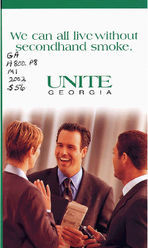We can all live without
secondhand smoke.
GArlgoz, p~
1'\1
:J..DOh
,$Sb
UNITE
GEORGIA
Why is it such a danger?
Secondhand smoke can cause the following in adults:* Eye and nasal irritation Lung and nasal sinus cancer Acute and chronic coronary heart disease leading to death
What if people smoke where you work?
On-the-job exposure to secondhand smoke can be four times higher than in the home.*
A non-smoker who lives in a non-smoking home faces a 27 percent increased risk of developing lung cancer if that person works in an environment where smoking is permitted.*
Some workers are already exposed to substances that can cause lung disease. Secondhand smoke in the workplace can only increase the danger.*
An eight-hour day (average work day) of exposure to environmental tobacco smoke is the same as smoking at least two or three packs of cigarettes.*
Non-smokers exposed to environmental tobacco smoke only at work had significantly higher levels of a nicotine metabolite, or cotinine, a hazardous chemical that remains in the body of habitual tobacco users and in non-smokers frequently exposed to smoke.*
Make Your Workplace 100% Smoke-free
Smoke-free worksites are beneficial to everyone. Take a look at some of the
benefits for employees and employers.
Benefits of a smoke-free work environment for employees*:
A smoke-free environment helps create a safe, healthy workplace.
A well-planned and carefully implemented effort by the employer to address the effect of smoking on employees' health and the health of their families shows the company cares.
Workers who are bothered by smoke will not be exposed to it at the worksite.
Smokers appreciate a clear company policy about smoking at work.
Managers are relieved when a process for dealing with smoking in the workplace is clearly defined.
Benefits of a smoke-free work environment for employers*:
A smoke-free environment helps create a safe, healthy workplace.
Direct health care costs to the company may be reduced.
Maintenance costs go down when smoke, matches and cigarette butts are eliminated in facilities.
Office equipment, carpets and furniture lasts longer.
It may be possible to negotiate lower health, life and disability coverage as employee smoking is reduced.
The risk of fires is lower.
For each smoking employee in the workplace, average yearly costs to the employer include: - $230 due to increased absenteeism with an average 15 percent more sick time taken by smokers than non-smokers.*
- $2,175 from decreased productivity due to an average of 30 minutes taken daily for cigarette breaks.*
- $75 in increased life insurance premiums.* - $85 for construction, operation and cleaning
of a smoking area on the workplace premises.*
What can you do to create a smoke-free workplace?
Find out your company's smoking policy. Ask what steps have been taken to protect the non-smoker from secondhand smoke. If you're not satisfied with the policy, talk to your employer.*
Be a leader and help create a plan for a smoke-free workplace. Ask co-workers what they want and would be willing to do.*
If your workplace is not smoke-free, use "Thank You for Not Smoking Around Me" signs in your work area.*
Know the law. In most states, employers must provide reasonably safe workplaces. This law may prove more powerful now that secondhand smoke is known to cause cancer.
To protect non-smokers from secondhand smoke, the workplace must be totally smoke-free or smoking must be limited to a separate, enclosed area with its own ventilation system.*
Secondhand smoke is dangerous, but is preventable. Call the toll-free tobacco Quit Line 1-877-270-STOP, Georgia's new free resource that offers counseling, a resource library and support and referral services for tobacco users.
We can all live without secondhand smoke.
What is secondhand smoke?
Secondhand smoke, also called environmental tobacco smoke (ETS), is the smoke exhaled from the lungs of smokers and the smoke that comes from the burning end of a cigarette, cigar or pipe. Exposure to secondhand smoke is called involuntary smoking, or passive smoking.
Who is at risk of the dangers of secondhand smoke?
Everyone.
Why is it such a danger?
The smoke from the burning end of a cigarette has many harmful chemicals. Secondhand smoke contains more than 4,000 chemicals, of which 200 are poisonous and 63 cause cancer. Secondhand smoke has been classified by the Environmental Protection Agency (EPA) as a known cause of cancer in humans (Group A carcinogen).
The Environmental Protection Agency (EPA) estimates that secondhand smoke causes approximately 3,000 lung cancer deaths and 37,000 heart disease deaths in non-smokers each year.*
* Note: Information obtained from the American Lung Association,
American Concer Society, International Journal of Cancer, American Nonsmokers' Rights Foundation and U.S. Deportment of Health and Human Services.
